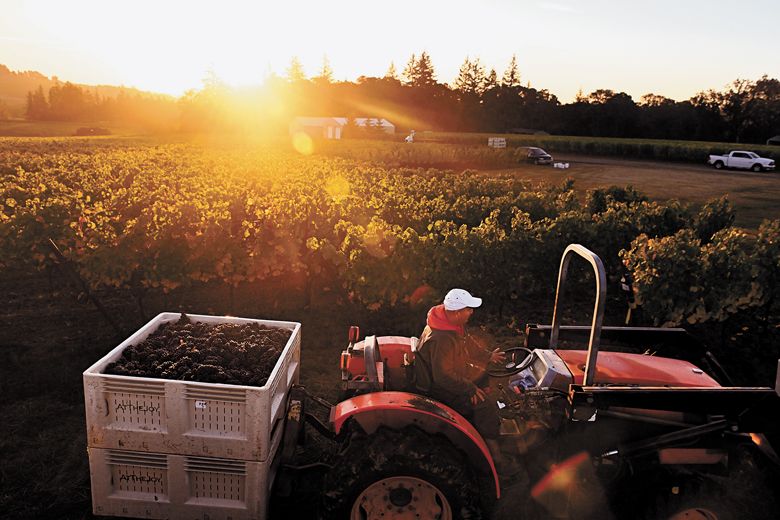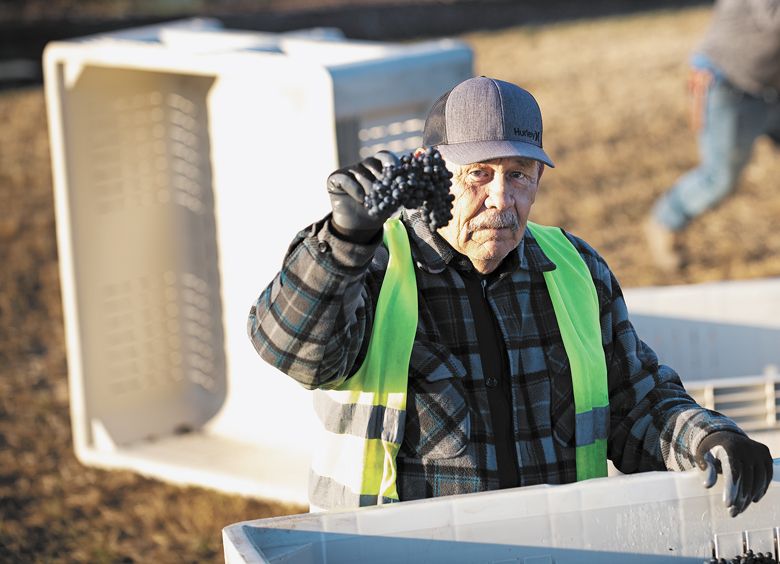Worth The Wait
Delayed growing season produces exceptional fruit


By Karl Klooster
This past April, disastrous predictions hovered over Northwestern Oregon’s 2022 wine harvest foretelling absolute gloom and doom. At mid-month, early bud break was well underway for Chardonnay, near mid-course for Pinot Noir and more than just beginning for most other varieties. Unfortunately, continuing cold, wet weather and persistent frost conditions settled in.
A thin layer of ice encircled cordons and canes in north Willamette Valley vineyards, which destroyed young primary buds. Southern Oregon experienced colder than normal conditions that damaged vines. In both regions; elevation influenced severity. In the north, lower elevation vineyards suffered more destruction from frost. In the south, the higher the sites the lower the temperatures. High humidity portended the prospect of powdery mildew.
The most calamitous assessment estimated a 30 to 50 percent decline in crops in the AVAs that sustained the least frost. Much vaunted vintner Ken Wright, who worked several vintages with top producers in Northern California before moving to Oregon in 1986, knew this was something Oregon growers had never experienced. He cautioned patience and careful evaluation before attempting to formulate any specific conclusions.
Leigh Bartholomew, director of viticulture at Results Partners, was one of the long-experienced Oregon winegrowers who realized circumspect attention must be afforded these unprecedented climatic conditions. She believed it wouldn’t be until early August before anything truly definitive would fall into place.
By early July, we knew that, although primary bud loss had occurred across the north Willamette Valley, the northernmost appellations suffered most, but only at certain sites. Chardonnay experienced the worst overall frost loss exacerbated by powdery mildew damage. As Bartholomew had predicted, by August, vineyard workers could estimate fruit load status and evaluate the overall situation with some degree of certainty.
Several vineyards in the most northerly appellations had, indeed, undergone up to 50 percent primary bud loss, but in most instances, a few buds survived. Those developed into larger berries yielding heavier, plumper clusters. In a few worst-case scenarios, secondary buds that erupting after the frost underwent full bloom and cluster development resulting in about half the normal tonnage with no loss of quality.
Alex Sokol Blosser of Sokol Blosser Winery in Dundee noted, “Even though the clusters have fewer, plumper berries, meaning less skin contact, the wines are deeply pigmented. Even more significant is the structure. Acid, tannins and phenolics all appear to be beautifully balanced, signifying the potential for long-lived, complex harmonious wines.”
His comments primarily apply to Pinot Noir, which represents 70 percent of all wine produced in Oregon, almost 84 percent is grown in the Willamette Valley AVA. Even more significant, since the variety’s average price per bottle is higher than any other wine, 2022 Willamette Valley Pinot Noir represent roughly 65 to 68 percent of the industry’s annual sales.
Ray Nuclo, King Estate’s director of viticulture and winery operations, related, “as with the north Willamette Valley, mid -and-south Valley frost and cold temperature bud damage resulted in fewer, heavier clusters. that yielded tonnages close to 2019 levels.” Nuclo shared, “They had a more compressed harvest time of two-and-a-half weeks as compared to the usual three-and-a-half-to-four weeks, which filled the winery to overflowing.” He also mentioned how bud break for King Estate’s signature grape, Pinot Gris, occurred later, escaping any cold or frost complications.
Dr. Greg Jones of Abacela Vineyards compared the Umpqua Valley’s situation with the rest of the state. “After a warm and dry winter came an early bud break, followed by a frost on April 15. The earliest varieties and blocks saw some damage to primary buds, but it was what happened afterward that set the stage for the growing season at Abacela, the Umpqua Valley, Oregon and across the Pacific Northwest.”
Jones continued, “A very cool and wet April continued into May and early June, when combined with the frost, vine growth was set back 2 to 4 weeks. Spring finally sprung just in time for flowering, producing a very good fruit set. Afterward, the heat turned on for the rest of the summer. With the soils full of water from the wet spring, the vines produced a healthy canopy to carry them through the season.
A glorious summer with almost no rain, and warm days but little heat stress allowed the vines to catch up a bit. September ended up nearly 3 degrees warmer than average and after a little rain around September 20-21, it dried out. October was also nearly 5 degrees warmer than average, with warm days and cool nights through the fourth week of the month, allowing for a phenomenal ripening period.” (Note: October actually became one of Oregon’s warmest months ever, a further indicator of climate change.)
“At Abacela and most places in the Umpqua Valley, early varieties started coming in during late September, a week to ten days behind average. It was a harvest without any measurable rain,” explained Jones. “Our last fruit came in on October 21, with higher than expected yields and slightly lower sugar levels than average, but wonderful flavors and balance.” Dr. Jones concluded, “We at Abacela are very happy with how things ended up and look forward to some wonderful wines from 2022.”
In the Elkton AVA, Southern Oregon’s coolest growing area, Terry Brandborg of Brandborg Vineyards expressed his appreciation that, in light of the various anomalies around the state, their vines came through the 2022 harvest unscathed. “This vintage looks to be an exceptional one for us, particularly given our emphasis on Pinot Noir. More than anything this year, even though nearby fires did bring some hazy days during the growing season, I’m happy to say it was nothing like 2020. We anticipate no problems related to smoke.”
Gina Bianco, executive director of Rogue Valley Vintners, spoke with a dozen producers from the Rogue Valley appellation to understand their 2022 experience. “While other parts of the state had impact from late frost, this was a minor issue in the Rogue Valley. However, a late spring hailstorm did damage some vineyards,” she said. “Heat was an issue at times over the summer, but smoke from fires in other areas of Oregon and Northern California caused some sun filtering in July and August.”
“Water availability also presented a challenge for some, but many vineyards with the soil and aspect to support it have turned to fully dry farming so they are seeing less issue with water stress. Others have invested in technology over the past few years to address water management, and it appears to be paying off.”
“As of the final days in October, harvest had wrapped up in most of the Rogue Valley. For those with grapes still hanging, they expect to pick everything left in the next week or two. Overall, the vintners are very happy with the quality of the fruit and have compared this year’s growing season to as close to perfect as they can remember. Some have compared it to the best in the Rogue Valley’s recent history, including the 2013 and 2018 vintages,” Bianco said.
According to Bartholomew, cold and frost conditions in 2022 had minimal impact in the Columbia Gorge AVA, where Bartholomew and her husband Patrick Reuter farm a vineyard for their Dominio IV Winery. Wet weather in the early spring kept them on alert for mildew, however. Results Partners’ Columbia Valley vineyards operations director Nick MacKay reported no severe seasonal weather factors affected the Milton-Freewater or Walla Walla Valley AVAs this season.
The 2022 vintage looks to be exceptionally fine in both areas.












